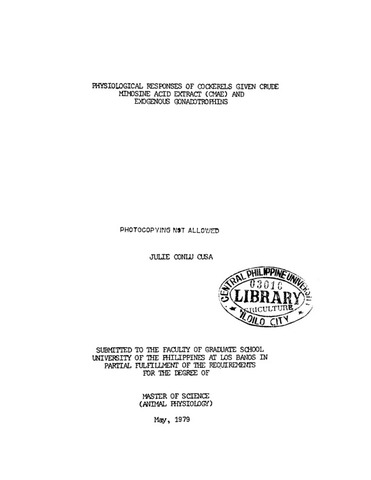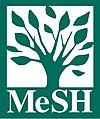Physiological responses of cockerels given crude mimosine acid extract (CMAE) and exogenous gonadotrophins

Page views
562Date
1979Author
Thesis Adviser
Defense Panel Chair
Share
Metadata
Show full item record
Abstract
A 2 x 4 factorial experiment was conducted to evaluate the effects of crude mimosine acid extract (CMAE) with or without exogenous gonadotrophins on the physiological responses of the cockerels; and to verify whether mimosine interferes with the availability of FSH and LH in circulation. Two levels of CMAE (0% and 17%) and four kinds of gonadotrophins (without gonadotrophin, with FSH, with LH and with FSH-LH combination) constituted the eight treatments (2x4) using a total of 48 cockerels representing two age groups. Twenty four one-month old cockerels represent the age to receive the various treatments before full reproductive functions are fully developed; and 24 eight-month old cockerels represent the age to receive the various treatments after reproductive functions are fully developed. The birds were randomly distributed to the different treatments with three birds per treatment, and each bird representing a replicate.
Results revealed that feed intake of both age groups was lowered when 17% CMAE was mixed in the diet. The lower feed intake resulted in a significantly lower weight gains. Regardless of the level of CMAE, administration of LH alone or in combination with FSH resulted to higher liveweight gains of both the one-month and the eight-month old cockerels.
The weights of the liver, kidney, spleen and heart of both age groups of cockerels were not affected by the CMAE level as well as the exogenous gonadotrophins.
The testes weight of the one-month old cockerels did not differ regardless of CMAE level in the diet and exogenous gonadotrophin administration. However, with the eight-month old cockerels there was a dramatic increase in weight of the testes as a result of the FSH-LH treatment, although testes weight was not affected with CMAE level in the diet, regardless of gonadotrophin administration.
The CMAE caused a decrease in the lymphocyte and an increase in neutrophil values of the eight-month old birds. The LH administration caused a decrease in the neutrophil count and an increase in the lymphocyte value of the one-month old cockerels. It also increased the RBC and hemoglobin values of the eight-month old cockerels.
Of the various parameters used in evaluating the physiological responses of cockerels to mimosine with or without gonadotrophins, the histological examination of the testes appears to be the most sensitive criterion. While the testes appears normal in looks, size and weight, the histological findings show some degeneration of the seminiferous tubules of the birds which received 17% CMAE. However, when gonadotrophins like FSH, LH and FSH-LH combined were administered to cockerels fed with rations containing 17% CMAE, the testicular tissues appear normal, similar to that of those which did not receive CMAE.
Description
Abstract only
Suggested Citation
Cusa, J. C. (1979). Physiological responses of cockerels given crude mimosine acid extract (CMAE) and exogenous gonadotrophins (Unpublished Master’s thesis). University of the Philippines at Los Baños, Laguna.
Type
ThesisSubject(s)
Department
Graduate SchoolDegree
Master of Science (Animal Physiology)Shelf Location
GSL Theses 610.72 C951
Physical Description
77 leaves
Collections
- Theses [10]


